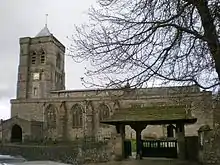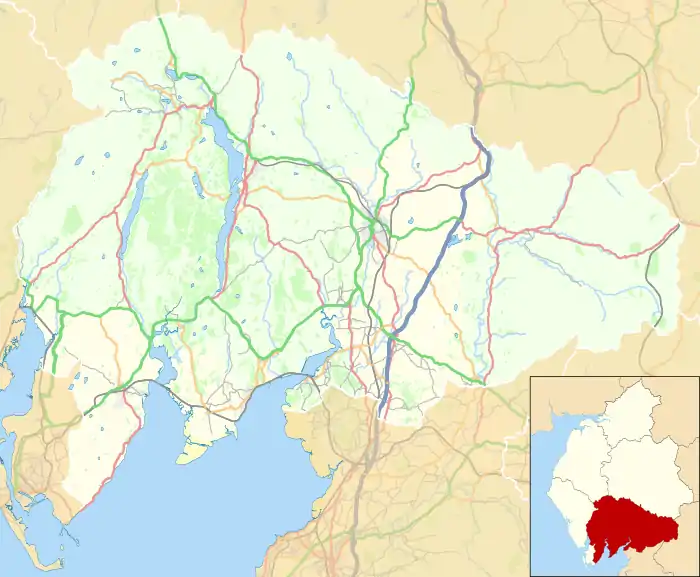St Peter's Church, Heversham
St Peter's Church is in the village of Heversham, Cumbria, England. It is an active Anglican parish church in the deanery of Kendal, the archdeaconry of Westmorland and Furness, and the diocese of Carlisle. Its benefice is united with that of St Thomas, Milnthorpe.[1] The church is recorded in the National Heritage List for England as a designated Grade II* listed building.[2] It stands on one of the oldest Christian sites in the historic county of Westmorland.[3]
| St Peter's Church | |
|---|---|
 St Peter's Church from the south | |
 St Peter's Church Location in South Lakeland  St Peter's Church Location in Cumbria | |
| OS grid reference | SD 496,834 |
| Location | Heversham, Cumbria |
| Country | England |
| Denomination | Anglican |
| Website | St Peter, Heversham |
| History | |
| Status | Parish church |
| Dedication | Saint Peter |
| Architecture | |
| Functional status | Active |
| Heritage designation | Grade II* |
| Designated | 12 February 1962 |
| Architect(s) | Paley and Austin (restoration) |
| Architectural type | Church |
| Style | Norman, Perpendicular, Gothic Revival |
| Completed | 1868 |
| Specifications | |
| Materials | Limestone and sandstone |
| Administration | |
| Parish | Heversham |
| Deanery | Kendal |
| Archdeaconry | Westmorland and Furness |
| Diocese | Carlisle |
| Province | York |
| Clergy | |
| Vicar(s) | Revd Susan Elizabeth Wilson |
History
The oldest fabric in the present church dates from the 12th century. Additions and alterations were made during the 14th, 15th and 16th centuries.[2] Rebuilding took place following a fire in 1601.[2][3] A considerable restoration was undertaken in 1868 by the Lancaster architects Paley and Austin, who also added the tower.[2] The restoration included rebuilding the north arcade, partly rebuilding the chancel arch, renewing the roofs of the chancel, and the aisles, and replacing the seating in the church.[4]
Architecture
Exterior
The church is constructed mainly in limestone rubble with sandstone dressings, the vestry and the east wall of the chancel being in sandstone. The roofs are covered in lead. The plan of the church consists of a three-bay nave with a clerestory, a two-bay chancel, north and south aisles with chapels at the east ends, a north vestry, a south porch, and a west tower. The tower is in three stages with buttresses, a pyramidal roof, and a southwest stair turret. The architectural style of the body of the church is Perpendicular. The south arcade is Norman. The tower is in Early English style.[2]
Interior
Most of the furnishings were designed by Paley and Austin, including the alabaster reredos. The screen in the north chapel dates from 1605. The south door is medieval, dating from about 1300. In the porch is a portion of an Anglo-Saxon cross dating from the late 8th century, carved with vine scrolls and beasts. Some of the stained glass in the south chapel is dated 1601. The glass in the east window was designed by William Warrington in 1844, and the glass in the south windows is mainly by Clayton and Bell. In the north chapel is a window dated 1914 by Shrigley and Hunt, and the west window of 1924 is by A. K. Nicholson. The church contains a number of monuments, the oldest dated 1626.[3] The three-manual organ was built in 1854, probably by Wilkinson. An earlier organ had been destroyed in the fire of 1601, and another organ is said to have been destroyed in the Civil War in about 1644. Improvements and repairs were undertaken on the present organ in 1887, 1925 and 1952, each time by Wilkinson. In 1979 Rushworth and Dreaper restored and extended it, and a complete overhaul was carried out in 1995 by David Wells at a cost of about £38,000.[5] There is a ring of six bells, all cast in 1870 by John Warner & Sons.[6]
External features
In the churchyard are a number of structures that have been designated as Grade II listed buildings. To the south of the church is a cross erected in 1920 as a memorial to those who died in the First World War. It is in the form of a Celtic cross, and was designed by J. F. Curwen.[7] The lych gate is dated 1894 and has sandstone piers with timber above, and a slate roof with a stone ridge.[8] Immediately to the south of the church is a table tomb to the Docker family, the earliest inscribed date being 1766.[9] To the south of this is another table tomb, this one being to the Crampton family, with an earliest date of 1760.[10] To the southeast of the church is a table tomb to the Dickinson family with an earliest date of 1763, although it was probably not erected until 1770.[11] To the south of the Dickinson tomb is a sandstone sundial dated 1690.[12]
See also
| Wikimedia Commons has media related to St Peter's Church, Heversham. |
References
- St Peter, Heversham, Church of England, retrieved 15 July 2011
- Historic England, "Church of St Peter, Heversham (1086557)", National Heritage List for England, retrieved 15 June 2012
- Hyde, Matthew; Pevsner, Nikolaus (2010) [1967], Cumbria, The Buildings of England, New Haven and London: Yale University Press, pp. 406–407, ISBN 978-0-300-12663-1
- Brandwood, Geoff; Austin, Tim; Hughes, John; Price, James (2012), The Architecture of Sharpe, Paley and Austin, Swindon: English Heritage, p. 223, ISBN 978-1-84802-049-8
- "NPOR N03596", National Pipe Organ Register, British Institute of Organ Studies, retrieved 2 July 2020
- Heversham, S Peter, Dove's Guide for Church Bell Ringers, retrieved 15 July 2011
- Historic England, "Memorial cross to the south of Church of St Peter, Heversham (1086559)", National Heritage List for England, retrieved 15 June 2012
- Historic England, "Lych gate to south of Church of St Peter, Heversham (1086558)", National Heritage List for England, retrieved 15 June 2012
- Historic England, "Docker table tomb immediately south of Church of St Peter, Heversham (1336084)", National Heritage List for England, retrieved 15 June 2012
- Historic England, "Crampton table tomb to the south of Docker tomb, Heversham (1086560)", National Heritage List for England, retrieved 15 June 2012
- Historic England, "Dickinson table tomb south of south east corner of Church of St Peter, Heversham (1137233)", National Heritage List for England, retrieved 15 June 2012
- Historic England, "Sundial south of Dickinson table tomb St Peter's churchyard, Heversham (1336085)", National Heritage List for England, retrieved 15 June 2012